As the sun goes down your eyes begin to adapt. At first your pupils dilate. Then photo-sensing chemicals needed in daylight drain away, and vision becomes over 50 times more sensitive, often without our notice until the sun is well below the horizon.
In order to preserve night vision, referred to as dark-adapted vision, safe reading lights should fall in the mescopic range (see the table with the adjacent story, “Night Vision and the Aging Eye”). This is the same range specified for military use.
Cone receptors, located primarily in the center of the retina become less efficient in this range. Because they are the cells that provide sharp focus and color, reading becomes difficult and fine details fade. Smaller type on charts becomes a blur and colors begin to flatten.
Rod receptors, more sensitive in low light but unable to distinguish color, then take over, allowing us to move about and see larger objects, like ropes, until it gets quite dark, perhaps 4,000 times darker than mid-day.
In the mescopic range, we are just entering the realm of fully dark-adapted vision that sailors need in order to keep watch across a moonless sea. The eye’s adaptation to this low level of light requires time, rigorous avoidance of bright light, and even relearning how you look at things.
Rods are far less sensitive to deep red light, so there is no question that properly dimmed red lights help preserve dark adapted vision. This is why for decades the military broadly adopted red lighting for infantry, naval, and aircraft night operations. “Rigging for red,” was the mantra.
Red light installations were also considerably more dim by design. But there are also downsides to red light, and the military standard for chart reading (MIL-STD-1472F) now allows either dim white or red light, at the option of the user.
We’ve used red headlamps and sailed boats with red cockpit lighting, and we’ve never been fully satisfied. We’ve gone so far as to temporarily cover cockpit chartplotters that could not be sufficiently dimmed. Based on our ongoing research in this area, we are convinced that most red “night vision” lights designed for use at the nav station are actually many times too bright to protect night adapted vision. As a result, we’ve modified our headlamps for reduced output (see “Make Your Own Cheap Diffuser,” above), but never made a detailed study of what is best and why.
What We Tested
We tested using Eveready Universal Plus headlamps, but everything we learned is transferable to fixed lighting. The Eveready has two colors, a white light that has an output of 100 lumens, and the red light that has an output of 30 lumens. At a normal working distance of about 12 inches, this produces about 1,000 and 300 candela of illumination per meter squared (Cd/m2) respectively.
Without a light meter, determining a light’s actual illumination (Cd/m2) based on lumens is difficult. In theory, 12.6 lumens of output from spherical light source produces 1 candela per square meter of light flux (illumination) at a distance of 1 meter. This is because the area of a 1-meter radius sphere is 12.6 square meters. However, most lights on our boat have a focused beam, so the total output is concentrated in a small area. A flashlight used at the normal chart reading distance of 12-18 inches, will have a cd/m2 rating as much as 10 times greater than its lumen rating, because the total output is focused on an area that is much less than one square meter.
If the light output is not given, white LEDs are about 75 lumens per watt and red LEDs are about 40 lumens per watt.
If your headlamp or nav station light is too bright, you don’t have to run out and buy a new one.
We found a cheap and easy solution: athletic tape. Sold in any pharmacy, or even in the supermarket, athletic tape used to tape ankles and elbows does an admirable job of diffusing the focused beams produced by common headlamps, and even by some fixed lights for navigation stations. Add more layers to get the right level.
- Some headlamps created a poorly focused beam that not only created glare, but was scattered.
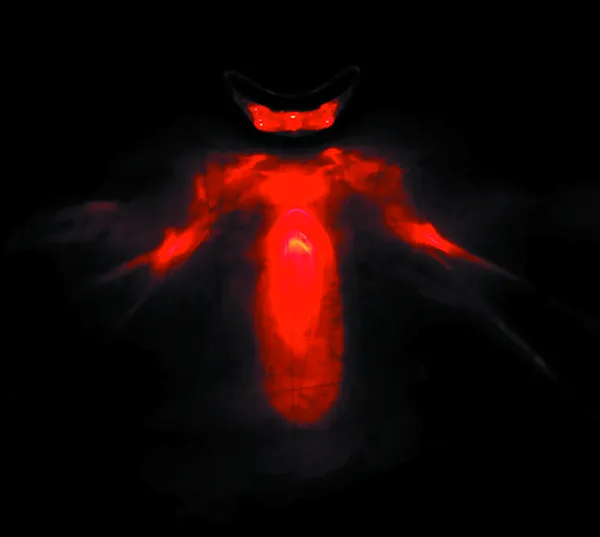
2. Athletic tape produces a more diffuse and more useful reading light than do neutral filters.
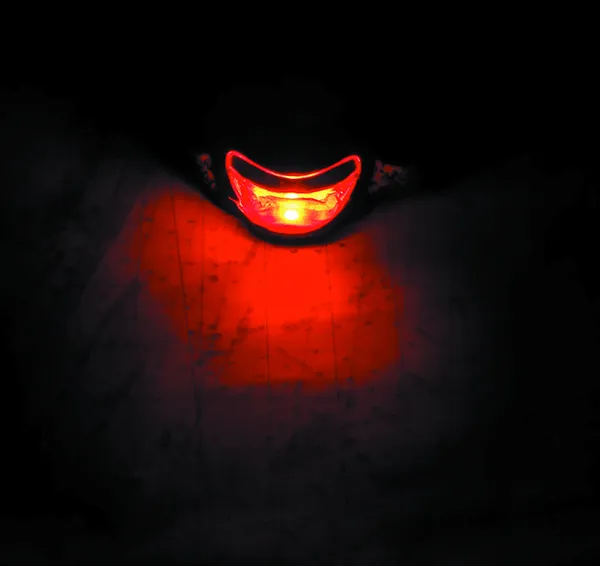
How We Tested
We narrowed the range of tasks to just two; reading charts and untying knots. The first tests our ability to see detail, the second tests our ability to see larger object. First, we allowed our eyes to adapt in a pitch black windowless room. Using a range of light intensities, adjusted by adding either neutral filters or tape to the headlamp in both red and white modes, we would try to read a specific set of chart details. We would then locate a number of ropes scattered on the floor, and tie and untie knots.
We dimmed each light until it was sufficient to tie knots but impossible to read chart detail. After accomplishing the test tasks, we would attempt to read magazine headlines in an adjacent room that was illuminated to the equivalent of starlight. In each instance, light output (lumens/m2) was measured with a photographic meter.
Observations
Really dim lights. In daylight, a headlamp that is dim enough for dark adapted viewing is barely noticeable as on. You should be able to stare into it, open-eyed. For operating at night, the military standard (MIL-STD-1472F) calls for a range of 0.35-3.5 cd/m2. Because of its focused beam, the 30 lumen red “night” light on our test lamp was about 20-100 times too bright by this standard, depending on how far the light was from the illuminated surface.
This is why after using non-shaded red lights for our test tasks we couldn’t even read the headlines on the magazines in the simulated starlight room until several minutes had passed. Based on our observations, many of the off-the-shelf red lights are too bright for eyes in a dark-adapted state.
Color. Light wavelength impacts color perceptions. The MIL-STD-1472F wavelength requirement for red lights for dark adaptation protection is > 625 nanometers (nm). Red LEDs (635-700 nm) are a suitable. If you use a filter to convert white lights to red through the use of filters, you will likely need to reduce the bulb wattage and use darkroom filters meeting this wavelength requirement.
Red Lights. Red light considerably degraded our ability to read a chart. Magenta lettering contains enough blue to be visible under red light, but that required a brighter light, which impaired night vision. (See below, “How a Red Chart Lights Can Lead You Astray”) Red and green aids to navigation are difficult to distinguish.
In the end, we needed nearly three times the intensity of red light to read the smallest magenta print. The literature suggests vision in the range of 20/200 is typical in dim red light, and that is close to what we experienced.
White light. White light, on the other hand, can be dimmer, because the cones are more far sensitive to it, and the cones pick up detail. Because you can “read” the chart more quickly with a white light, your eyes will quickly readapt, because your eyes’ exposure to the light was short.
In our test, we could immediately read the headlines in our “starlight room” if either red or white light was dim enough. In both cases we need about 5-10 minutes to recover our full night vision. What differed was the amount of time we needed to spend looking at our chart. We could read the charts far more quickly in the dimmer white light.
Customized Lights
Because you are reading this under typical room illumination, the accompanying photos understate the differences between the appearance of a chart read with dim red light versus one with a white light. The most notable difference is color.
As we continued dimming the lights, we concluded that having a red nav light did not interfere with moving around on the boat—a priority for a boat off soundings and away from traffic. We could see what we needed to tie a few knots in very dim light. We couldn’t see detail, but we weren’t “night blind.”
We also noticed the hallmarks of true night vision. When your eyes have fully adapted to low light, you develop a blind spot in the center of your view, the same area where you normally focus and perceive detail. That is because there are not enough rods in the fovea, or center of the retina, to be effective. Colors go away.
This is why scanning a horizon at night is better than staring at an object like a distant running light. If you stare, objects can fade from view in 2-3 seconds. Objects may also appear to move (autokinesis) if you look at them too long, because the usual visual clues about relative motion and location are missing. Instead, slowly scan your surroundings and the horizon using a regular pattern so that you don’t miss anything.
Military research is based on young service members. The average sailor, based on our reader demographic, is about 57. Myopia and wearing glasses further impairs night vision.
The military spec says 0.3-3.5 cd/m2 is all the light you need to read a chart, but as you age, the minimal amount of light required increases significantly. A person with good night vision requires no more than 15 cd/m2 to see, but as you age this number increases. An person with average to above average night vision is likely to need 15-25 cd/m2.
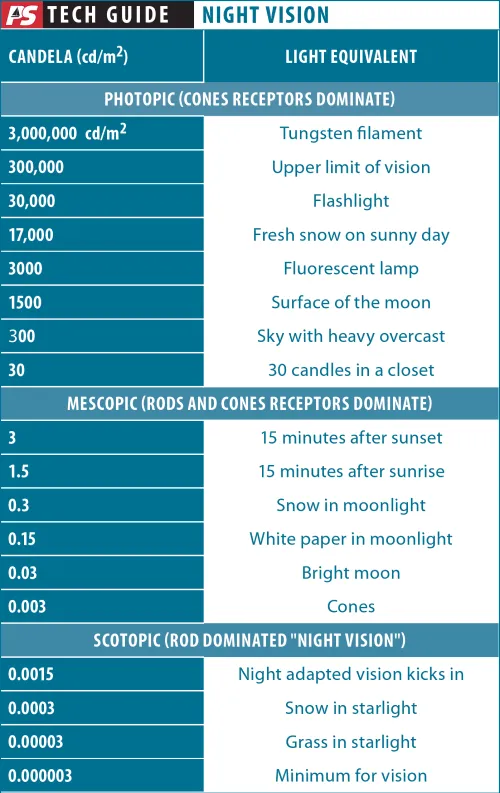
The theory of using dim lights to protect the eye’s ability to adapt to darkness involves keeping light levels in the mescopic range. However, the amount of light required for older eyes to read is well into the photopic range, meaning every time a light is used to read a chart, your eyes will need a much longer time to recover. Small wonder we have become more dependent on radar and plotters. We can’t see beans.
The solution? Better light discipline. Clear the decks and cabin so that you don’t need light to move about below. Lay out any gear or snacks that will be needed. You should be able to find the head or grab your rain gear in pitch black conditions. Turn off instruments you don’t need and cover instruments you aren’t actively using.
Do you really need the compass and sounder full-time during an autopilot passage? Leave the radio on, but cover the display. Ask that crew members not wear unshaded headlamps; one flash in the eyes at short range and you can’t see right for 30 minutes.
If you must use cabin lights, reduce the number and block them from view on deck. Warn people before you use a bright light or open the companionway. Avoid alcohol and even worse, tobacco. Both degrade night vision. Wear sunglasses during the day; prolonged exposure to overly bright light reduces dark adaptation for 12-24 hours.
Multi-function displays (MFDs), chart plotters, and smart phones can usually be dimmed. Smart phones can be dimmed and set to red for night use. However, if you can read them, they are almost certainly far too bright to fully protect dark adapted vision and should be covered or turned off whenever it is not actually necessary to look at them.
You can read a chart under dim light, because this is only for a few minutes and your eyes will re-adapt in 10-15 minutes. But a display is in front of you constantly, subtly blinding you, without your noticing. Note that the MIL standard for instrument reading is just as dim as for chart reading, with either red or white permitted.
Methods of dimming
We tried several methods to control brightness and were quite pleased when we found one that worked great and didn’t cost an arm and a leg.
Dimmer Switch. This is a good solution for fixed lighting. The risk, of course, is setting it too bright. Also, dimmers on LEDs can be prone to flickering unless properly mated to the lamp.
Window tint. We like tinted film for instruments that would not dim. A simple solution is to take an extra cover, cut out the viewing area and slip the window tint in. The tint is widely available in various levels of shading for about $10 for a 12 square foot roll. (Avoid the reflective film—just plain neutral density). On black and white displays red film is even better.
Tape. One of the handiest ways to dim a light, red or white, is to use two to eight layers of common athletic tape. It’s easy to tear, stays on in wet conditions, is reliably translucent (we measured 50 percent transmission), and produces a comfortably diffuse light with less glare.
The dimmest red light we could use for chart reading required three layers of tape and was 3.1 cd/m2. Seven lumens (about 70 cd/m2) was more suitable for our old eyes, or about 20 times the military standard. In our view, athletic tape produces a more diffuse, usable reading light than neutral filters, with less glare.
Night Vision: Headlamps and Nav Station Lights
| MANUFACTURER | AQUA SIGNAL CHART LIGHT | DR. LED CHART LIGHT | DR. LED CHART LIGHT | ENERGIZER HEAD LAMP | ENERGIZER HEAD LAMP $ | MANTUS SNAP-ON LIGHT |
|---|---|---|---|---|---|---|
| MODEL | Garabone | Cobra | Recessed chart light | Universal Plus | Vision HD | Snap-On Light |
| TYPE | Flexible | Flexible | Installed | Headlamp | Headlamp | Rail clamp |
| POWER | Installed | Rechargeable | Installed | 2 x AAA batteries | 3 x AAA batteries | Rechargeable |
| TIME | NA | 3-6 minutes | NA | 9-18 minutes | 8-50 minutes | 16-100 minutes |
| FOCUSED or FLOOD | Focused | Focused | Flood | Focused | Focused | Flood |
| WHITE | ||||||
| WATTS | 9 W | 2 W | 3 W | - | - | <1-2 W |
| LUMENS | 630 (calculated) L | 150 L | 145 L | 100 L | 200 L | 7/45/140 L |
| RED | ||||||
| LUMENS | 120 | 45 | 45 | 25 | 25 | 7 |
| WATER RESISTANT | No | No | No | No | Yes | Yes |
| TESTED | No | No | No | Yes | Yes | Yes |
| PRICE | 35 | 90 | 45 | 8 | 12 | 69 |
The Big Red Advantage
As much as we like dim white light for reading and detail work, we like red for moving around the deck, evaluating sail trim, and general sailing. Although you can’t see fine detail, it seemed to have less impact on dark adaptation and it reduced the risk of being blinded by looking closely at the light.
Because red is more visible to the rod than the cones, the night-blind spot is reduced, although vision in the focus area will still be blurry. As little as 3-5 cd/m2 was quite suitable for untying a knot and other tasks not requiring detailed vision or color perception.
Choosing products
Sure, we could research the heck out of lights to find a light with the ideal brightness, but the military has already done that work. As the standards for military spec night lights state:
When maximum dark adaptation is not required, low brightness white light shall be used; however, when maximum dark adaptation is required, low luminance [0.07 – 0.35 cd/m2] red light shall be provided.
It is important to note that the mil spec is based on young eyes. If, like our testers, you are over 50, please read the ”Aging Eyes” sidebar and adjust as needed. In our view, you should be able to easily adjust brightness to suit varying conditions.
Because this review did not focus on testing products, we offer only a brief table that should suggest some of the things to look for. See also “Headlamp Roundup,” Practical Sailor, May 2008.
- Light output. Based on the U.S. military standard (MIL STD 1472F Table XVI) a 70 cd/m2 white light is best for normal chart reading. Depending on the working distance and whether the light is focused or flood, this can range from focused white 20-lumen headlamp to a 400-candela dome light that is one meter away your chart. For dark adapted vision, only about 0.5-5 lumens are required with a focused lens and about 1.5-14 lumens with a dome or other flood lamp at 18 inches.
This can mean you’ll have to do some shading with film or tape. We found at least one clip-on light, the Snap-On Light by Mantus, that is dim enough (red or low white) for use with dark adapted vision without additional shading. Be careful to slightly close your eyes when cycling any lamp through the brighter settings. On the high setting, it is bright enough for a cockpit area light once your eyes have adjusted. Other features to consider include:
- Water resistance. For cockpit and headlamps this is vital.
- Batteries vs. installed. For chart tables down below, permanently installed lights make sense. However, a sailor who doesn’t do many night passages could use a rechargeable light here since batteries are easily changed or recharged, and the light is only used for a brief look now and then.
- Headlamp vs. fixed. The advantage of a head lamp is that you have it when you need it. The down side is that non-shaded headlamps can really blind people, to the extent that some skippers ban them.
- Decklights. These are not for dark adapted eyes. If it is bright enough for use in harbor it is probably 100 times too bright.
We could read the charts far more quickly under dim white light and made far fewer mistakes. But neither is easy if the light is sufficiently dim. These photos understate the difference in the human eye’s ability to detect fine detail in very dim red vs. white light. They primarily show the difference in color rendition.
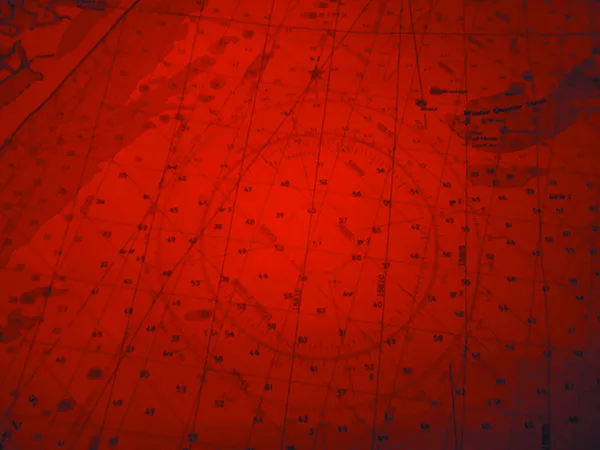
- Red chart markings, such as this compass rose, are still legible under red light because they are actually magenta.

2. Shades of blue, green, and tan are all grey under red light, interfering with the navigator’s ability to distinguish features.
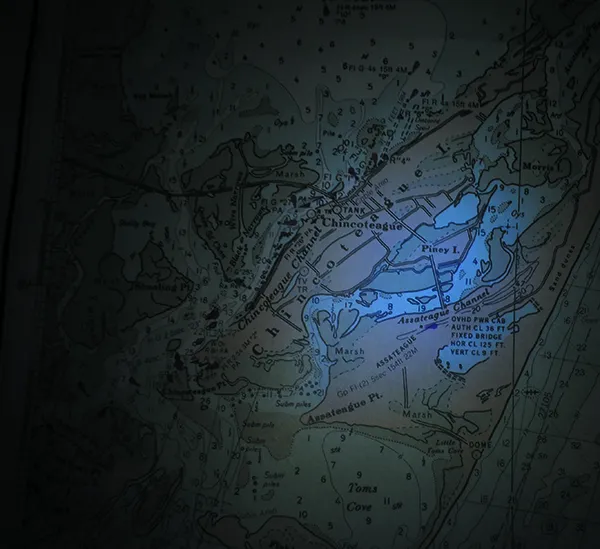
3. Through a basic neutral filter light is more concentrated. The lack of uniformity means your eye, as with a red light that obscures some colors, again has to work harder to distinguish features.

4. Any evenly diffused white light has been proven to be easier on the eyes in several studies. When properly dimmed, it will not interfere with night vision. The exposure of this photo was boosted for printing, so it is actually darker than it appears.
Conclusions
It’s tempting to grab a flashlight when you can’t see, and subsequently rely on your plot charter, radar, and depth sounder, since your eyes no longer work. But only dark adapted eyes will spot a small boat running dark, a floating log, or breakers over an uncharted shoal.
If there is one clear finding, it is all of your cockpit lighting and head lamps require dimming. Nearly all stock lights are too bright to preserve fully adapted night vision. Even red lights are often 10-20 times too bright.
The red vs. white choice is not as clear as it used to be. The military leaves it up to the operator to decide. You need cones to read detail, but cones are not sensitive to red, so you often need too much red light to read quickly, and colors are muted. If you are digging around a locker for something colored (a blue safety tether, for example), a dim white light is better than red. On the other hand, moving around on deck requires only perception of shapes, and a red light will serve just fine.
How can you tell if the light you are buying—red or white—is dim enough? With white lights you need 20 lumens/m2 of illuminated area, adjustable to 3.5 lumens/m2 if possible. Red output, on the other hand, is often not stated by the manufacturer, and all you can do is go by the eyeball test; the illuminated object should be no brighter than an overcast sky.
So what do we suggest? Get some athletic tape, apply some layers to dim your lights, and decide which “setting” works for your eyes.
After weeks of testing it became clear that red worked best on deck and a very dim white light served well in the cockpit. A taped head lamp has also worked well for us over the years, with the red adjusted just bright enough for us to move around, and the dim white adequate for reading a chart in the dark. We keep a bright head lamp near at hand but not worn on watch, and a strong, focused flashlight is available for spot-light duty.
There is no one-size-fits-all answer here.






























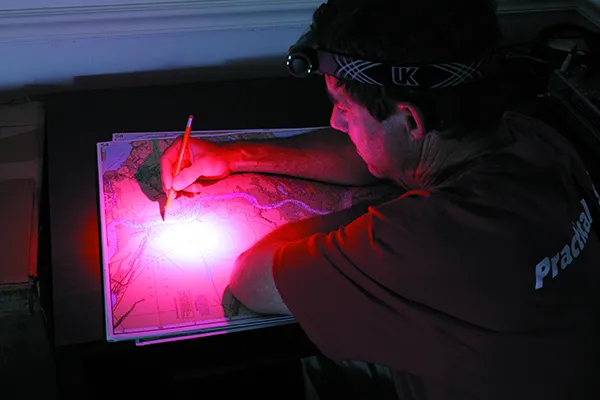








During my 1996 delivery to Nuuk…the nighttime vision issue was SUN was in our eyes and we needed a flashlight to see the compass between 10pm and 2am.
A great article. A couple of points:
LEDs generally to not output a continuous spectrum like a filament bulb does, there are spikes of different colors. Some “white” LEDs are quite deficient in the red wavelengths, so the watt to brightness calculations when using a red filter may be off.
Finally, be careful with night vision goggles, they output mostly green and blue light and very little red, so you will have trashed night vision when you take them off.
A great article. A couple of points:
LEDs generally to not output a continuous spectrum like a filament bulb does, there are spikes of different colors. Some “white” LEDs are quite deficient in the red wavelengths, so the watt to brightness calculations when using a red filter may be off.
Finally, be careful with night vision goggles, they output mostly green and blue light and very little red, so you will have trashed night vision when you take them off.
Illuminating article (ha)! I’m curious how night vision is affected when viewing our multi-function displays/chart plotters. They can be dimmed, but often still seem too bright. Any strategies to optimize using these tools for night sailing?
In the astronomy world, there are advocates for dim pure green and pure orange for star chart reading because of the acuity issue you mention. Red light has to be turned up brighter for the same ability to distinguish details and the chart coloring issue makes this worse.
Green: http://www.astromax.org/activities/members/kniffen.htm
Orange: Ken Wishaw. https://nla.gov.au/nla.obj-2001684180/view
Good stuff. Agree that tape is the best, but a neutral filter over the chart plotter is the best solution for that.
You can also cover one dark-adapted eye, either with a patch or your hand, if you need to turn some lights on. It actually works OK.
Noticing vs Seeing: Noticing things in the dark is partly a learned skill apart from the eye’s technical capacity to see in the dark. In darkness, to scan the sea around you or walk around deck in darkness and notice there is something there takes some combination of skill/practice/belief/confidence/something. I teach my grandchildren ages 4-12 to see in the dark, walk around in the dark, see shadows, find things, be able in the dark, not need flashlights for everything.
(this may not apply to reading fine detail on paper charts or reading screens)
I use blue painters tape (because I have it) on all the idiot lights on my engine panels when motoring at night as well as the idiot lights on my ZF Commander throttle stations. Without the tape, it’s like looking at someone’s headlamp. A disturbing trend is Navico’s replacement of older radios with orange-tinted displays with new models with white displays. The H60 remote handset lights up half my cockpit when squelch breaks at night! I had no such problems with the older model (now discontinued).
RE athletic tape. Adhesive tape would leave a residue on the lens. There are many types of tapes. What were you recommending? Blue tape on idiot lights is a good idea. Less residue.
An illuminated magnifier that sits on a paper chart might be a good solution if the light source can be changed to a filament bulb for intensity adjustment. Perhaps the Eschenbach VisoLux could be adapted. It might be worthwhile contacting them.
Yes, displays are often too bright. I throw a towel over them when not needed.
On my last boat I made neutral density filters from dark window tint film for depth and wind instruments. The were fitted inside an extra set of instrument covers, with the the center display section cut out. I just slid them on when needed, like clip-on sunglasses.
Good article! Good tip of the athletic tape. I have always wondered about the preference for red lights since I have seen pictures of airplane cockpits at night where red lighting has been abandoned completely. Even though they may not need to work at light levels as low as mariners at sea do, since pilots usually work with lighted runways to land on.
One remark on scanning the horizon: it is always, also during daytime, a good idea to scan the horizon slowly. Our eyes do not look continuously but they jump: when scanning the eye takes small steps and takes in another image after each step (I think it is called saccadic eye movement). If you scan fast, you skip sections without knowing. At night this may be the cause for not finding a small light on the horizon of which you are sure you saw it just before. This is all distinct from the night vision issue.
Good article. Spent a career in the Marines as an infantryman. All the same stuff used for night ops except we use a small red lens pen light with tape over it and a pin prick hole in the tape for ti y steam of red light to study maps while under a poncho to prevent any light to escape.
On my boat we have no chart plotter in the cockpit. A dim red light in our compass and we dim the depth sounder or turn it off offshore. The cockpit is completely dark except for ambient light. Operating in black out conditions is a learned skill. Clear side decks and unobstructed access to the mast at night is a safety issue.
Thanks for a lot of detail in this article.
Great article on a little-known subject matter. As a military pilot flying night missions, I turned down our cockpit instrumentation lights to the lowest level possible. Retaining maximum “night vision” was essential, especially flying formation with your wingman a few feet from your wing, night in-air refueling, and low-level bomb runs. I find instruments on boats, chart plotters, and other electric displays too bright, like the night flying pilot helmsmen need to be able to see what lurks in front of the boat. It may seem counterintuitive, but the less light, the better you can see at night. Great safety article. Please keep them coming.
I found an oblong flashlight (about 4″ by 1 1/2 “) with hinged magnifying lens that can lay flat on the chart and give off a diffused white light.
It was in a dollar store!
I bought four and modified two with red bulbs, wish I knew the manufacturer, I’d tell every sailor I know about them.
They are reliable as all are working after ten or more years.